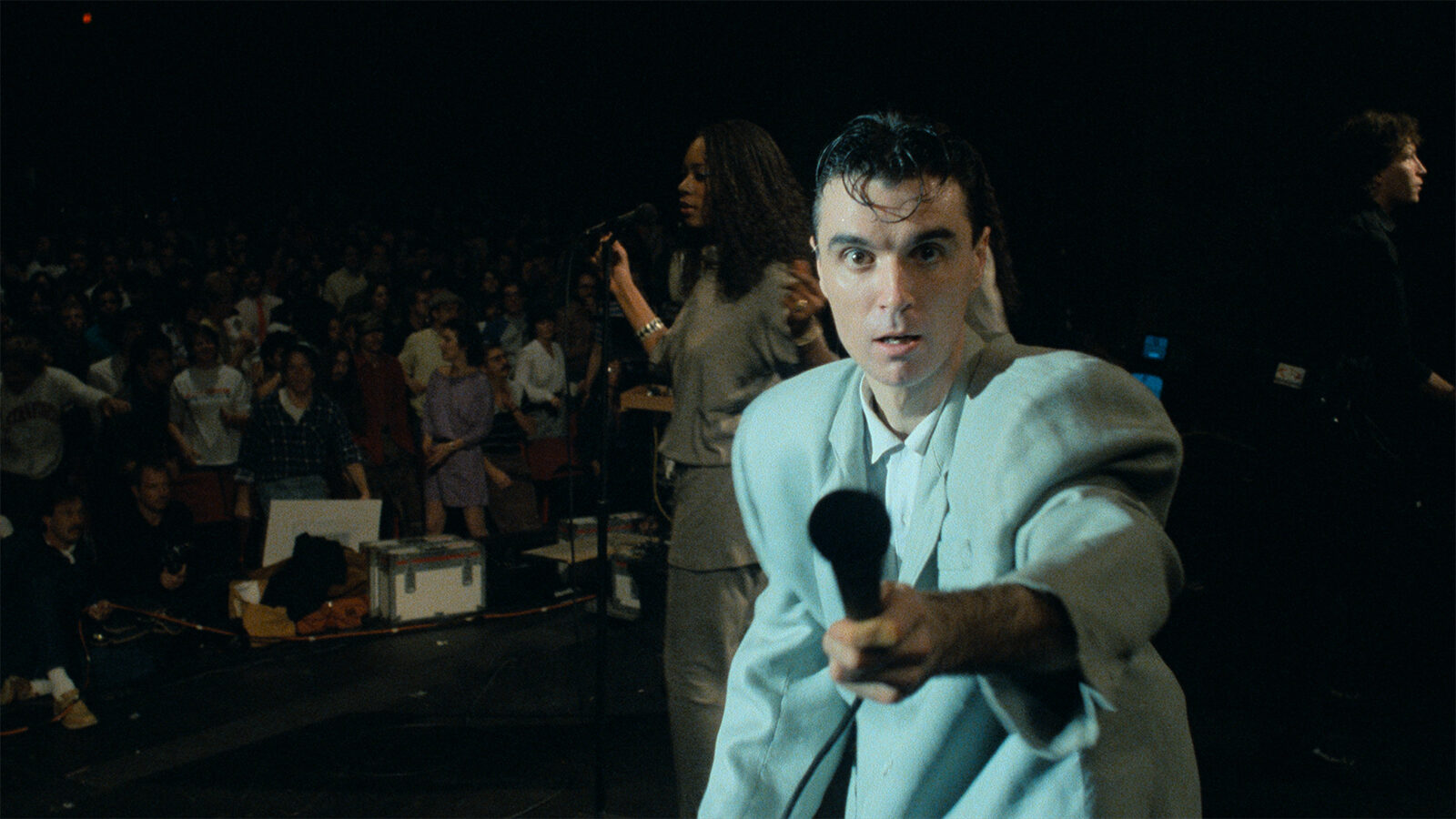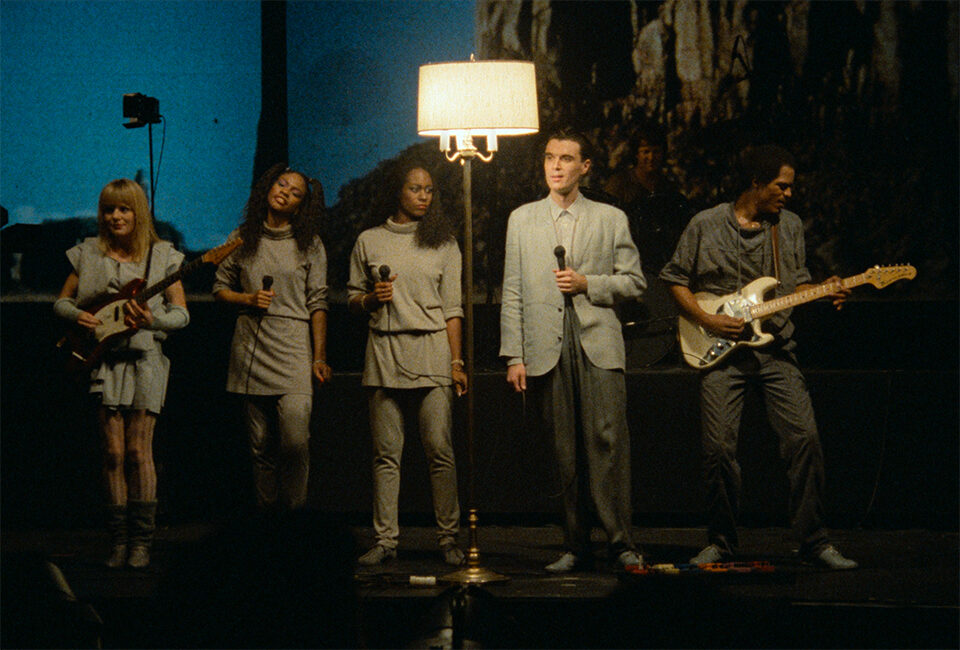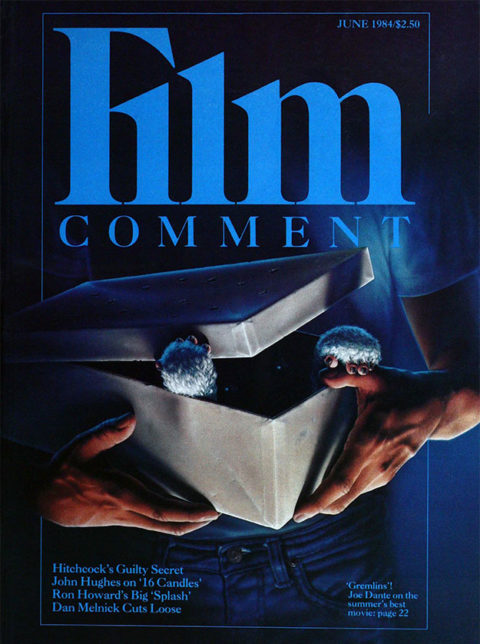By Michael Sragow in the May-June 1984 Issue

Heads Will Roll
Jonathan Demme’s call to rock and roll faith
The ability to confront the world’s worst aspects and still sing life’s praises is something that director Jonathan Demme and the art-rock group Talking Heads share, and it helps turn their concert documentary, Stop Making Sense, into an exhilarating experience-almost a call to rock ’n roll faith.
Initially, however, it is hard to think of a less likely collaboration. Demme, after Citizens Band and Melvin and Howard, has turned out rather sappy offerings of Americana that even he has referred to as “sweety-pie movies.” Talking Heads, under the leadership of David Byrne—often called the Norman Bates of rock—are famous for such arresting tunes as “Psycho Killer,” “Life During Wartime,” and “Burning Down the House”—hardly sweet material. But the cheering qualities of Demme’s movies shouldn’t disguise their preoccupations with such unsettling subjects as bigamy (in both Crazy Mama and Citizens Band), the fantasies fostered by the media, and working-class alienation (whether in the comic mode of Melvin or the melodramatic mode of Fighting Mad); just as the Talking Heads’ eye contact with the abyss shouldn’t obscure their hopes that people will get happy either by finding jobs or by facing the music and dancing.
Filmed last December 17, 18, and 19 at the Hollywood Pantages, Stop Making Sense is thrilling testimony to Demme’s and the Heads’ audiovisual virtuosity and empathy. Demme captures the group’s high-energy theatricality and manic-depressive verve. And the movie establishes the group once and for all as an A-plus positive force. After experiencing their intense, original bopping and wailing, a viewer feels refreshed and recharged, fit to fight ennui and enervation. And making this film has worked a charm for Demme—it’s taken him straight past the winter of his discontent into springtime.
Throughout the winter of ’83, Demme had been enmeshed in the bitterest fights of his career over the completion of Swing Shift, a Rosie-the-Riveter comedy-drama written by Nancy Dowd, Ron Nyswaner, and Bo Goldman and starring Goldie Hawn, Kurt Russell, Fred Ward, Ed Harris, and Christine Lahti. What Demme had rhapsodized over during shooting as a dream movie turned into a nightmare. At Hawn’s behest, new scenes were written (reportedly by Robert Towne) and shot, and Demme’s cut was severely re-edited. Hawn apparently had felt that she didn’t come off as an attractive heroine, spiritually or physically; one production source told the L.A. Times that during re-shooting, “They threw enough lights on her face to illuminate the city of Glendale.”
In the meantime Demme and his long-time music co-ordinator, Gary Goetzman, were laying plans for filming the director’s “all-time favorite rock group,” Talking Heads. Demme had first seen them live at a daytime concert in Central Park in 1978, when they were still performing as a simple four-piece band; it was after seeing them last summer in L.A., at the Greek Theater stop of their Speaking in Tongues tour, with five more performers and an intricate stage act, that he began to consider them as the basis for a movie.
“Beyond it being a terrific music show,” Demme says now, “I detected an emotional progression in their selection of songs, and I detected a character beyond ‘there’s the drummer, there’s the bass-player’—real characters were being created there.” A mutual friend of Goetzman’s and David Byrne’s arranged a meeting between Demme and the group. “I told them it was an incredibly cinematic show already, and the way to see it to best advantage was to make it into a film. We could make the lighting, for example, happen in a way that’s difficult when you’re on tour and you’re only in a venue for a night. And I told them I wouldn’t want to do it with a lot of quick cuts, which seem to be so popular these days, but rather with long takes. And I didn’t want to go the route of constant cutaways to the audience. And that all sounded real good to them. It appealed to their sense of craftsmanship.” Talking Heads raised the money (roughly $800,000) themselves, and the movie is now ready for release.
Demme has always been a director who puts himself at the service of his stories; in Stop Making Sense he puts himself at the service of the band. He and his Citizens Band cinematographer, Jordan Cronenweth, deployed six locked-in cameras, one hand-held, and one Panaglide to capture the Talking Heads’ every quirk and nuance. Cronenweth, sometimes called a “slow” cinematographer, would seem to be an odd choice for a concert film, but Demme thinks this reputation is unfair: “Jordan isn’t a slow cinematographer, he’s a painstaking cinematographer; it takes a lot of time and work for him to set the lights correctly, but once he does he goes like blazes.”
With a core of three ex-Rhode Island School of Design students, and a fourth member who studied architecture at Harvard, the Heads have developed a visual style that, like Demme’s, is both austere and electric—a sort of Bauhaus flamboyance.

Stop Making Sense (Jonathan Demme, 1984)
The movie is as pure as it is exciting: There are no interjected interviews, and no flashy camerawork to get in the way of the Talking Heads’ own graphic inventiveness. Demme, Cronenweth and visual consultant Sandy McLeod were able to call for the best shots via headphones during shooting. Indeed, Demme tips his hat to the movie audience only in one quick shot near the end, when we see him stare intently, headphones on, at the action on stage. It illustrates what makes him a good concert-film director: he’s the perfect audience.
The movie begins focused on the shoes of David Byrne as he ambles onto the empty stage with a modest ghettoblaster (a suburb-blaster?), announces “I got a tape I want to play,” then launches into his trademark number, “Psycho Killer.” Demme keeps the camera trained on this slender, tall, vibrating crazy with hyper-thyroid eyes as he sings “Psycho killer, qu’est-ce que c’est?/ fa fa fa fa fa fa . . . ”, giving us a larger view of the stage only when Byrne seems overtaken by a synapse breakdown, his jumpy but rhythmic motion deteriorating—no, splintering—into a ratchet-like stumble.
Out of the corner of the camera’s eye we see the female bass-player, Tina Weymouth, take the stage, and before Byrne would seem to have a chance to recover, they break into the mock-lullaby tones of “Heaven”: “Everyone is trying to get to the bar/. . . the bar is called Heaven/. . . Heaven is a place where nothing ever happens . . . ” What’s striking about these opening numbers is both their contrast and their unity. The heaven where nothing happens is the one that might well be imagined by the psycho killer who “can’t face up to the facts,” who’s “tense and nervous and can’t relax.” The appearance of the lissome, blonde Weymouth, her curved hand strumming the bass while it rests on her hip with a subtle seductiveness, doesn’t just expand the band—it shades and softens Byrne’s abrasive presence. As the opening Bauhaus flourish continues, and the elfin guitarist, Jerry Harrison, and the exuberant drummer, Chris Frantz, roll out onstage, the show develops a pulsing tension of focus and expansion.
Byrne hardly ever ceases to be the center of attention, yet his role in the performance goes through quicksilver changes. He’s at once star and leader and shaman, and he dramatizes his transformations with some of the most eloquent, idiosyncratic gestures ever used by a pop singer. While he sings of all the dizzying dislocations of urban life today, he’s apt to hold his arms out and down at right angles to his body, his head jutting forward, as if he were resisting crucifixion; he also slaps his hand against his head like a hyper kid struggling to hang onto his train of thought. He even runs circles around the stage, as if to celebrate the transcendent power that the human body can drum up all by itself. For all his whirligig motion, though, he remains the anchor of the group. The others watch over him protectively, and sometimes with unconcealed amusement—especially Tina Weymouth, who, up close, has a mischievous baby-doll look.
Even with the addition of three more musicians (guitarist Alex Weir, percussionist Steven Scales, and Bernie Worrell on the synthesizer) and two backing dancer/vocalists (Ednah Holt and Lynn Mabry), the band remains a group-full of individual temperaments able to stop in unison on a stylus. They do a cover of Al Green’s “Take Me to the River” that has bench-thumping gospel fervor. And in their most recent syntheses of white American angst and African rhythms (songs like “Slippery People” with its exhortatory chorus “Turn like a wheel within a wheel”) they seem to have created their own solar system. That’s one of the group’s liberating messages: you can borrow from all the influences that bombard you, from diverse cultures and even from technology, and create your own order from chaos. If it’s hard to “find yourself a city to live in,” you can at least set up a keen apartment.
Demme puts us in what he calls “the roving best seat in the house. ” Like The Last Waltz, this film doesn’t rely for excitement on shots of the pumped-up live audience, but unlike The Last Waltz, it gives you the illusion of seeing a continuous performance. And the sense of continuity is necessary, for the Talking Heads’ act is structured to build thematically, visually and even kinetically. Just when you think their inventions have ceased, Byrne bounds on-stage in a big padded suit, as if to see just how many changes he can work on the theme of mutation. The performers keep up their skittering, wheel-within-wheel movement by regrouping and changing instruments. Byrne playfully alters the lighting for each number, at one point even pulling off the flashlight-under-the-chin trick for the Devil song, “Swamp.” We see slides of the artwork already displayed on Talking Heads albums, such as the four views of a chair from Speaking in Tongues.
The most ambitious numbers bring all of the group’s stage elements together. In “Making Flippy Floppy,” for example, disparate words in white letters flash on three red screens (“STAR WARS”; “ONIONS”; “FACELIFT”) while the lyrics contrast the idea of “nothing” and the idea of “everything”: “Everything is divided/nothing is complete/Everything looks impressive/Do not be deceived.” As the lights brighten and you see the band’s vitality—Byrne joining Harrison in a shuffle, Bernie Worrell playing the synthesizer like a joystick, guitarist Alex Weir beaming at the audience—you realize that the group has come to an understanding of nothingness not as an ideal state but as an honest starting-point. (Call it Ethical Nihilism.) Demme and Cronenweth add their own visual coups: Hearing “We are born without eyesight, born without sin,” the moviegoer is temporarily blinded by the light.
Like the happenings and performance artists of the Sixties, Talking Heads (to borrow Sontag’s phrase) practice “an art of radical juxtaposition”: they use concentrated, often ripped-from-the-headlines language, shifting points of view, and shock tactics to capture the tensions and confusions of 20th century life. They often keep repeating the pun that they want to help us “loose” our mind. But unlike the artists of the happenings, they don’t use their power simply to shake up the audience; they recognize that the world outside has shaken up the audience already. And they’re not just trying to release the irrational fears that lurk beneath the linoleum—they’re trying to exorcise our demons.
Demme sums up the group’s evangelical power when he says, “Their songs tend to give a feeling about how rough and violent and complicated life is today. But they still manage to take you to the river.”








